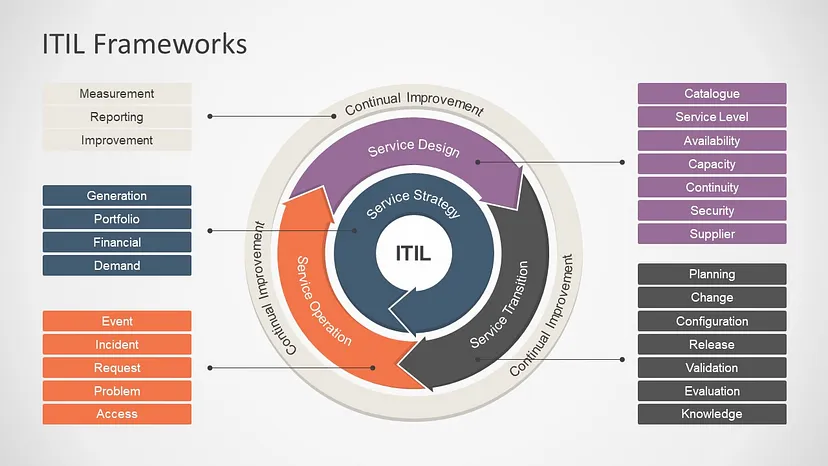An In-Depth Guide to ITIL: Understanding the IT Infrastructure Library
 Sumit Mondal
Sumit MondalTable of contents

Introduction
In today's fast-paced and technology-driven world, organizations heavily rely on Information Technology (IT) to deliver products, services, and maintain seamless operations. To ensure IT services are efficient, reliable, and aligned with business objectives, there needs to be a well-defined framework in place. This is where ITIL, short for the Information Technology Infrastructure Library, comes into play. ITIL is a globally recognized set of best practices designed to streamline IT service management (ITSM) and enhance the overall IT service delivery process. In this blog, we will delve into the intricacies of ITIL, exploring its history, components, benefits, and practical applications.
- A Brief History of ITIL
The roots of ITIL can be traced back to the late 1980s when the United Kingdom's Central Computer and Telecommunications Agency (CCTA) developed a collection of publications, initially known as "Government Information Technology Infrastructure Management" (GITIM). Later, in the early 1990s, it was renamed the IT Infrastructure Library (ITIL). The primary objective of ITIL was to standardize and improve IT service management practices across government agencies.
Over the years, ITIL evolved and gained popularity beyond the public sector, becoming a globally adopted framework for ITSM in various industries. Today, ITIL is managed by AXELOS, a joint venture company between the UK Cabinet Office and Capita plc.
- Key Components of ITIL
ITIL comprises a series of books, known as "core publications," each focusing on a specific stage of the IT service lifecycle. As of my knowledge cutoff in September 2021, the most recent version is ITIL 4, which includes the following core components:
A. ITIL Service Value System (SVS): The Service Value System is the core of ITIL 4 and represents a flexible operating model for delivering value to customers through IT-enabled services. It consists of several components, including:
Service Value Chain (SVC): A set of interconnected activities that create and deliver value to customers. The SVC consists of six stages: Plan, Improve, Engage, Design & Transition, Obtain/Build, and Deliver & Support.
Guiding Principles: Fundamental values and guidelines that shape an organization's decision-making and behavior. Some of the key principles include Focus on Value, Start Where You Are, and Collaborate and Promote Visibility.
Governance: Defines the processes and policies for ensuring that organizational objectives are achieved efficiently and ethically.
Practices: A set of management practices that encompass both ITIL practices and other complementary practices relevant to service management.
B. ITIL Practices: These practices offer detailed guidance on specific areas of ITSM. Some of the key ITIL practices include:
Incident Management: The process of restoring normal service operations as quickly as possible after an incident.
Change Management: The process of controlling the lifecycle of all changes to IT infrastructure, services, and other configurations.
Problem Management: The process of identifying the root causes of incidents and addressing them to prevent future occurrences.
Service Level Management: The process of defining, monitoring, and reporting on service levels and ensuring they align with business needs.
Continual Improvement: A practice that helps organizations constantly enhance their services, processes, and technology.
C. ITIL Service Value Stream (SVS): The Service Value Stream represents a sequence of steps an organization uses to create and deliver products or services to customers. It emphasizes the flow of work and value through the SVC.
- Benefits of ITIL Implementation
Implementing ITIL offers numerous advantages for organizations of all sizes and industries:
A. Improved Service Quality: ITIL emphasizes customer-centricity and enables organizations to deliver high-quality services that align with customer needs and expectations.
B. Enhanced Efficiency: The ITIL framework streamlines processes, reduces redundancies, and optimizes resource utilization, resulting in improved operational efficiency.
C. Faster Incident Resolution: Organizations can quickly identify and resolve issues with well-defined incident management processes, minimizing downtime and business disruptions.
D. Effective Change Management: ITIL's change management practices ensure that changes are controlled, reducing the risk of service disruptions and failures.
E. Better Decision-Making: ITIL's guiding principles provide a solid foundation for making informed and strategic decisions that support business objectives.
F. Greater Return on Investment (ROI): By aligning IT services with business goals, organizations can achieve a higher ROI on their IT investments.
- Practical Applications of ITIL
ITIL can be applied to various aspects of IT service management and business operations, including:
A. Service Desk Operations: Implementing ITIL practices in the service desk enhances incident management, problem resolution, and customer support.
B. Change Management: ITIL's change management process ensures that changes to IT services and systems are well-planned, assessed, and approved before implementation.
C. Service Level Agreements (SLAs): ITIL helps in defining and managing SLAs, ensuring that service levels are met and measured.
D. IT Service Continuity: ITIL practices assist in disaster recovery planning and business continuity to minimize service disruptions.
E. Service Portfolio Management: ITIL supports organizations in managing their service portfolios, ensuring the right services are developed and maintained to meet customer demands.
Conclusion
In conclusion, ITIL is a powerful framework that serves as a guiding light for IT service management. Organizations can enhance efficiency, quality, and customer satisfaction by focusing on delivering value to customers and aligning IT services with business objectives. Whether you are a small business or a multinational corporation, implementing ITIL practices can help you stay ahead in the ever-evolving world of technology while maintaining a strong focus on your customers' needs. Embrace ITIL and unlock the true potential of your IT services for a successful future.
Subscribe to my newsletter
Read articles from Sumit Mondal directly inside your inbox. Subscribe to the newsletter, and don't miss out.
Written by

Sumit Mondal
Sumit Mondal
Hello Hashnode Community! I'm Sumit Mondal, your friendly neighborhood DevOps Engineer on a mission to elevate the world of software development and operations! Join me on Hashnode, and let's code, deploy, and innovate our way to success! Together, we'll shape the future of DevOps one commit at a time. #DevOps #Automation #ContinuousDelivery #HashnodeHero